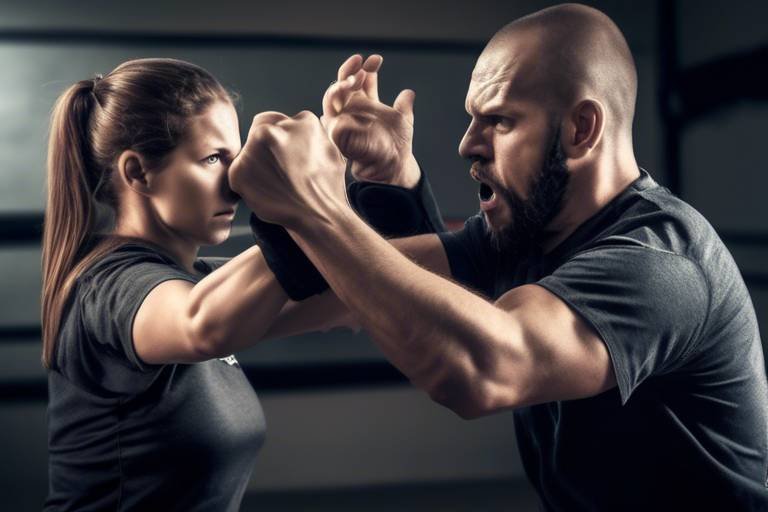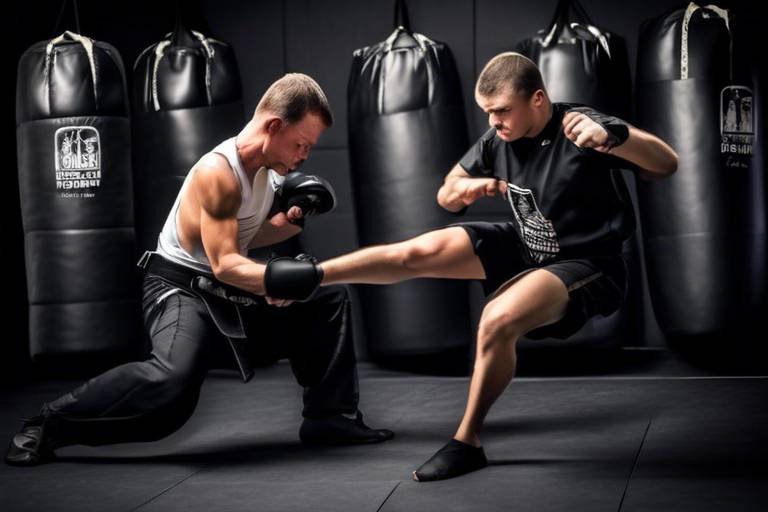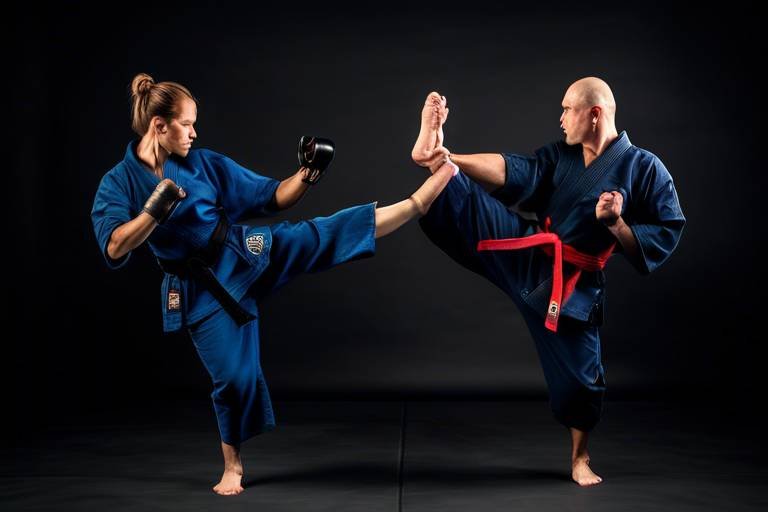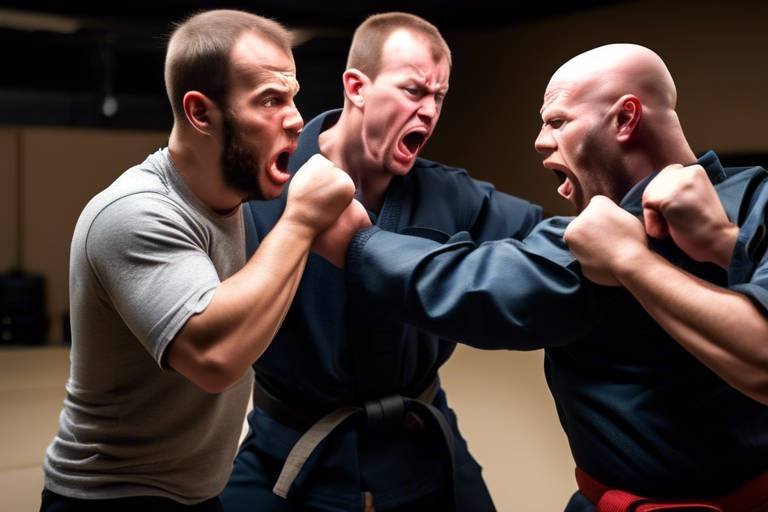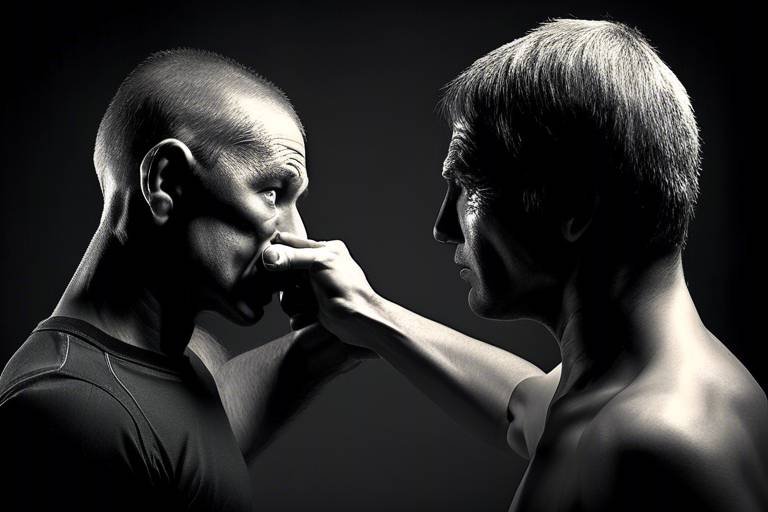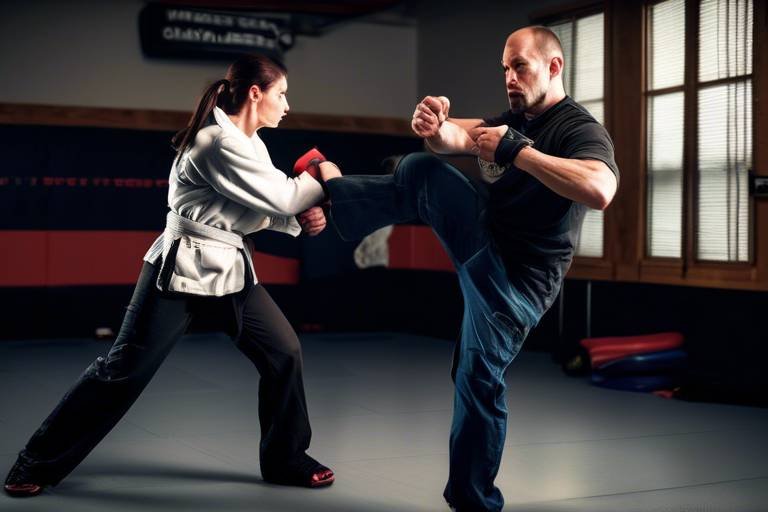How to Prevent Panic Attacks with Self-Defense Training?
In today's fast-paced world, many individuals experience anxiety and panic attacks that can disrupt their daily lives. But what if I told you that there’s a powerful tool at your disposal that not only helps you defend yourself but also equips you with the skills to manage anxiety? Self-defense training can be a game-changer in preventing panic attacks. It’s not just about physical techniques; it’s about building a mindset that can combat fear and uncertainty. In this article, we’ll dive into how self-defense training can empower you to regain control over your emotions and enhance your overall well-being.
Understanding the relationship between self-defense training and anxiety management is essential for anyone looking to combat panic attacks. When you engage in self-defense training, you’re not just learning how to throw a punch or escape a hold; you’re also developing a sense of empowerment. This empowerment comes from knowing that you have the skills to protect yourself, which can significantly reduce feelings of vulnerability and anxiety. As you practice, you learn to trust your instincts and capabilities, which can create a profound shift in your mental state. Imagine walking into a room with your head held high, fully aware that you have the tools to handle any situation. This newfound confidence is a powerful antidote to anxiety.
One of the most significant benefits of self-defense training is its ability to enhance self-esteem and confidence. When you learn and practice self-defense techniques, you are not only preparing yourself physically but also mentally. Each successful technique you master builds your belief in your abilities. This can be especially beneficial for individuals who struggle with anxiety, as it fosters a sense of control. Here are some techniques that can contribute to greater self-assurance:
- Consistent Practice: Regularly attending classes helps reinforce skills and build muscle memory.
- Setting Achievable Goals: Start with small milestones and gradually work toward more complex techniques.
- Positive Reinforcement: Celebrate your progress, no matter how small. Every step counts!
Incorporating mindfulness practices into self-defense training can significantly improve focus and reduce anxiety. Mindfulness teaches you to be present in the moment, which is crucial when learning self-defense techniques. By focusing on your breath and being aware of your surroundings, you can enhance your training experience. For instance, before starting a session, take a moment to breathe deeply and visualize yourself executing techniques flawlessly. This practice not only calms your mind but also prepares you mentally for what’s to come.
Breathing exercises are essential for maintaining calmness during self-defense training. When anxiety strikes, our breathing often becomes shallow, which can exacerbate feelings of panic. Here are some effective breathing techniques to help manage anxiety:
- Deep Breathing: Inhale deeply through your nose for a count of four, hold for four, and exhale through your mouth for a count of four. Repeat this several times.
- Box Breathing: Inhale for four counts, hold for four counts, exhale for four counts, and hold again for four counts. This method can help stabilize your heart rate.
Visualization techniques can enhance performance in self-defense training. By picturing yourself successfully executing a technique, you prepare your brain for real-life situations, reducing panic. Imagine a scenario where you need to use your self-defense skills. Visualize the steps you would take, the techniques you would use, and the confidence you would feel. This mental rehearsal can significantly reduce anxiety and help you react more effectively in stressful situations.
Engaging in physical fitness through self-defense training not only improves your physical health but also plays a crucial role in reducing anxiety. Exercise releases endorphins, which are natural mood lifters. When you engage in self-defense, you’re not just learning how to protect yourself; you’re also getting a great workout. This combination of physical activity and skill-building can lead to a healthier mind and body. Think of it as a two-for-one deal: you’re getting fit while learning to be your own protector!
Participating in self-defense classes fosters social interaction and support, which can be incredibly beneficial for those struggling with panic attacks. Being part of a community that shares similar goals can create a sense of belonging and reduce feelings of isolation. In these classes, you’ll meet people who understand your struggles and can offer encouragement. This social aspect is crucial for emotional resilience.
Creating a network of supportive individuals through self-defense classes can enhance your emotional resilience. By connecting with others, you can share experiences, tips, and encouragement. It’s like having a built-in support system that motivates you to keep pushing forward. You’ll find that many of your classmates may also be facing challenges with anxiety, creating a unique bond that can lead to lasting friendships.
Accountability among peers in self-defense training can motivate individuals to face their fears. When you have friends who are also working on their self-defense skills, you’re more likely to show up and put in the effort. This mutual support can lead to better outcomes in managing panic attacks. Think of it this way: when you’re part of a team, you’re less likely to let yourself down because you don’t want to let your teammates down either.
Q: Can self-defense training really help with anxiety?
A: Absolutely! Self-defense training empowers individuals, builds confidence, and provides tools to manage anxiety effectively.
Q: Do I need to be physically fit to start self-defense training?
A: Not at all! Self-defense classes cater to all fitness levels, and you’ll improve your fitness as you progress.
Q: How often should I practice self-defense to see benefits?
A: Consistency is key. Aim for at least one class a week, combined with practice at home.
Q: Are there specific self-defense techniques that are better for anxiety management?
A: Techniques that involve breathing and mindfulness are particularly effective for managing anxiety.

The Connection Between Self-Defense and Anxiety Management
Understanding the intricate relationship between self-defense training and anxiety management is vital for anyone grappling with panic attacks. Imagine this: you're in a situation that feels overwhelming, and your heart races, your palms sweat, and suddenly, you feel trapped in a whirlwind of fear. Now, picture yourself equipped with the skills and knowledge to handle such scenarios. This is where self-defense training comes into play, acting as a powerful antidote to anxiety.
Self-defense training isn't just about learning to throw a punch or execute a perfect kick; it's about empowerment. When individuals engage in self-defense classes, they often experience a significant boost in their self-esteem and confidence levels. This newfound confidence can be transformative. Think of it as donning an invisible armor that shields you from the debilitating effects of anxiety. The psychological benefits are profound: participants often report feeling more in control of their lives and less susceptible to panic.
Moreover, self-defense training offers a structured environment where individuals can confront their fears head-on. This practice of facing fears in a controlled setting can desensitize the anxiety response. By simulating real-life situations that may trigger panic, individuals learn to manage their reactions effectively. It’s akin to preparing for a storm; while you can’t stop the rain, you can learn to navigate through it with confidence and resilience.
In addition to the physical techniques learned, the mental aspect of self-defense training cannot be overlooked. It encourages a mindset shift, where individuals start viewing challenges as opportunities rather than threats. This shift is crucial in anxiety management. The more one practices self-defense, the more they develop a sense of mastery over their body and mind. They begin to understand that they have the tools to protect themselves, not just physically but also mentally.
Furthermore, self-defense training fosters a sense of community. Participants often bond over shared experiences, creating a supportive network that can be invaluable for those dealing with anxiety. This camaraderie can help individuals feel less isolated in their struggles, as they realize they are not alone in facing their fears. In essence, self-defense training becomes a holistic approach to managing anxiety, combining physical, mental, and social elements to create a robust strategy for overcoming panic attacks.

When it comes to building confidence, self-defense training is like a treasure chest filled with tools that can significantly enhance your self-esteem and empower you to face life's challenges head-on. Imagine walking into a room full of people and feeling like you can take on the world; that's the kind of confidence self-defense can instill in you. It's not just about learning how to throw a punch or execute a perfect kick—it's about embracing a mindset that says, "I can handle whatever comes my way." The journey of self-defense training equips you with practical skills, but it also transforms your mental landscape, allowing you to approach situations with a newfound sense of security and assurance.
One of the most impactful ways self-defense training builds confidence is through mastery of techniques. As you practice and improve, you gain a sense of accomplishment that boosts your self-worth. Each time you successfully execute a move, it’s like adding another brick to the foundation of your confidence. You start to realize that you are capable of more than you ever thought possible. This realization can be incredibly empowering, especially for those who struggle with anxiety. Just think about it—when you know how to defend yourself, you naturally feel more secure in your surroundings. This shift in perception can help alleviate feelings of vulnerability that often accompany anxiety.
Another technique that plays a crucial role in building confidence is the emphasis on physical fitness that comes with self-defense training. Engaging in regular physical activity not only improves your health but also releases endorphins, the body’s natural mood lifters. When you feel good physically, it reflects in your mental state. The combination of physical prowess and mental resilience creates a powerful synergy that can combat feelings of panic and anxiety. The more you train, the stronger and more capable you feel, which can significantly reduce your fear of facing difficult situations.
Moreover, self-defense training encourages a supportive community. Participating in classes allows you to meet like-minded individuals who share similar goals. This social interaction can be a game-changer for someone dealing with anxiety. The camaraderie developed in these settings fosters a sense of belonging and support, which is crucial for building confidence. You’re not just training alone; you’re part of a team that encourages you to push your limits. This shared experience can create lasting friendships and a network of support that helps you navigate life's challenges more effectively.
In addition to these elements, self-defense training often incorporates goal-setting strategies. Setting achievable goals—whether it’s mastering a particular technique or improving your fitness level—provides a roadmap for progress. When you achieve these goals, no matter how small, it reinforces your belief in your abilities. This process of setting and achieving goals can be a powerful antidote to the feelings of inadequacy that often accompany anxiety and panic attacks. You learn to celebrate your successes, which in turn fosters a more positive self-image.
Lastly, it’s essential to remember that self-defense training is not just about physical techniques; it’s a holistic approach to personal development. The skills you acquire extend beyond the dojo or training space. They seep into your daily life, allowing you to approach challenges with a proactive mindset. You start to see obstacles as opportunities for growth rather than threats, which is a fundamental shift in perspective. This transformation is what makes self-defense training an invaluable tool for anyone looking to build confidence and manage anxiety effectively.

When you think about self-defense training, you might picture intense physical workouts, adrenaline-pumping techniques, and maybe even some sparring. But what if I told you that there's another layer to this training that can profoundly impact your mental state? Mindfulness is the secret ingredient that can transform your self-defense practice into a powerful tool for managing anxiety and panic attacks. By incorporating mindfulness into your training sessions, you can develop a deeper connection with both your body and mind, allowing you to respond to stressors with clarity and calmness.
So, how does mindfulness fit into the picture? Well, mindfulness is all about being present in the moment. It encourages you to focus on your thoughts, feelings, and bodily sensations without judgment. Imagine stepping onto the mat, ready to practice a new technique. Instead of letting your mind race with worries about your performance or what others might think, mindfulness teaches you to center your attention on your breath and the movements of your body. This practice not only improves your self-defense skills but also significantly reduces anxiety.
In a typical self-defense class, you might engage in various activities that can be enhanced through mindfulness:
- Warm-up exercises: Use this time to tune into your body, noticing how it feels as you stretch and move.
- Technique practice: Focus on the mechanics of each move, allowing yourself to experience the flow of the technique without distraction.
- Cooldown sessions: Reflect on your training, acknowledging your progress and setting intentions for your next session.
By practicing mindfulness in these areas, you create a mental space that can greatly reduce anxiety. It’s like turning down the volume on that inner critic that often tells you, “You can’t do this!” Instead, you’ll find yourself saying, “I am capable, and I am here.” This shift in mindset is crucial, especially when faced with panic-inducing situations.
Moreover, mindfulness in self-defense training can lead to improved focus and decision-making skills. When you're calm and centered, you're better equipped to think clearly in high-pressure situations. This mental clarity can mean the difference between feeling overwhelmed and taking decisive action when it matters most. You’ll find that as you practice staying present, your confidence will grow, and with that, your ability to manage anxiety effectively.
To further enhance your mindfulness practice in self-defense training, consider integrating specific mindfulness techniques:
- Breathing exercises: Focus on your breath to ground yourself. Inhale deeply through your nose, hold for a moment, and exhale slowly through your mouth.
- Body scans: Take a moment during your training to mentally scan your body, noticing areas of tension and consciously relaxing them.
- Visualization: Before practicing a technique, visualize yourself executing it perfectly, feeling confident and in control.
In conclusion, mindfulness is more than just a buzzword; it's a transformative approach that can enhance your self-defense training and provide you with tools to manage anxiety and panic attacks. By being present, you not only improve your physical skills but also cultivate a resilient mindset that empowers you to face challenges head-on. So, the next time you step into a self-defense class, remember to embrace mindfulness. It’s not just about learning to defend yourself; it’s about building a stronger, more confident you.
Q: How can mindfulness improve my self-defense skills?
A: Mindfulness helps you stay focused and present during training, allowing you to absorb techniques more effectively and respond calmly in stressful situations.
Q: Can mindfulness really help with panic attacks?
A: Yes! Practicing mindfulness can reduce anxiety and panic by teaching you to manage your thoughts and feelings, leading to a greater sense of control.
Q: Do I need to be experienced in self-defense to practice mindfulness?
A: Not at all! Mindfulness can benefit individuals at any skill level. It’s about being present and aware during your training, regardless of your experience.
Q: What are some quick mindfulness exercises I can do before training?
A: Simple exercises include deep breathing, body scans, or visualizing your success in a technique. These can help center your mind before you start.

When it comes to managing anxiety and panic attacks, breathing exercises stand out as one of the simplest yet most effective tools at our disposal. Think of your breath as your personal anchor; it can ground you in moments of chaos and help you regain control. The beauty of these exercises lies in their accessibility—you can practice them anywhere, anytime. Just imagine being in a crowded room, feeling your heart race, and instead of succumbing to panic, you take a moment to breathe deeply and center yourself. Sounds empowering, right?
One of the most popular techniques is the 4-7-8 breathing method, which has gained traction for its effectiveness in promoting relaxation. Here’s how it works:
- Inhale through your nose for a count of 4 seconds.
- Hold your breath for a count of 7 seconds.
- Exhale slowly through your mouth for a count of 8 seconds.
By repeating this cycle a few times, you can feel your body start to relax. This technique not only helps to calm your mind but also reduces physiological symptoms of anxiety, such as elevated heart rate and shallow breathing.
Another excellent exercise is the diaphragmatic breathing technique. This method involves breathing deeply into your diaphragm rather than your chest, which can significantly enhance oxygen flow and promote a state of calmness. To practice this, follow these steps:
- Find a comfortable position, either sitting or lying down.
- Place one hand on your chest and the other on your belly.
- Inhale deeply through your nose, ensuring that your belly rises while your chest remains still.
- Exhale slowly through your mouth, feeling your belly fall.
As you focus on your breath, visualize each inhale bringing in peace and each exhale releasing tension. This visualization can enhance the calming effect, making it a powerful addition to your self-defense training routine.
Incorporating these breathing exercises into your self-defense training not only prepares you physically but also mentally. When faced with a stressful situation, having a toolbox of calming techniques can make all the difference. Just like a martial artist practices their moves until they become second nature, you can train your body to respond to anxiety with calmness and clarity.
So, the next time you feel the weight of anxiety creeping in, remember that your breath is a powerful ally. By practicing these exercises regularly, you can cultivate a sense of calm that enhances not only your self-defense skills but also your overall well-being.
Q: How often should I practice breathing exercises?
A: It's beneficial to practice breathing exercises daily, even when you're not feeling anxious. This way, they become a natural response when anxiety strikes.
Q: Can breathing exercises really help with panic attacks?
A: Yes! Breathing exercises can significantly reduce the intensity of panic attacks by promoting relaxation and helping you regain control over your body’s response to stress.
Q: Are there any specific breathing techniques for beginners?
A: Absolutely! Beginners can start with simple deep breathing: inhale through the nose for a count of 4, hold for 4, and exhale through the mouth for 4. As you become comfortable, you can explore other techniques like the 4-7-8 method.

When it comes to mastering self-defense, visualization techniques play a pivotal role in enhancing both performance and confidence. Imagine preparing for a big test or a crucial presentation; what do you do? You mentally rehearse the scenario, right? This is exactly how visualization works in self-defense training. By picturing yourself successfully executing techniques, you’re not just dreaming—you’re programming your mind for success.
Visualization is like a mental rehearsal that allows your brain to create a roadmap for your actions. When you visualize a self-defense situation, your mind engages in a kind of practice that can significantly reduce anxiety. It’s as if you’re training in a safe space, where the only limit is your imagination. This mental exercise helps you to anticipate challenges and prepare for them, making you feel more in control and less likely to panic when faced with real-life situations.
To get started with visualization techniques, try the following steps:
- Find a Quiet Space: Choose a calm environment where you can focus without distractions.
- Close Your Eyes: Close your eyes and take a few deep breaths to center yourself.
- Visualize the Scenario: Picture yourself in a self-defense situation. Imagine every detail—the location, the people around you, and the feelings you might experience.
- Engage Your Senses: Don’t just see the scenario; feel it. Hear the sounds, smell the air, and even feel the ground beneath your feet.
- Practice Your Techniques: Visualize yourself using the techniques you’ve learned. Picture yourself moving with confidence and precision.
Research shows that mental imagery can lead to improved performance, whether in sports, arts, or self-defense. This technique not only helps in honing your skills but also builds a sense of familiarity with the actions you'll take. The more vividly you can imagine your success, the more likely you are to achieve it in reality. Think of it as a mental dress rehearsal that prepares you for the stage of life, reducing the fear of the unknown.
Furthermore, visualization can also be a powerful tool for managing panic attacks. By practicing positive imagery, you can create a mental sanctuary that you can retreat to when anxiety strikes. This sanctuary can be a place where you feel safe, strong, and capable. Whenever you feel the onset of panic, you can close your eyes and transport yourself back to this peaceful place, reminding yourself of your strength and resilience.
Incorporating visualization into your self-defense training routine can be a game-changer. Not only does it prepare you for physical confrontations, but it also equips you with mental strategies to combat anxiety. Remember, the mind is a powerful ally in your journey towards confidence and self-assurance. So, the next time you step onto the training mat, take a moment to visualize your success, and watch how it transforms your experience!
Q: How often should I practice visualization techniques?
A: Ideally, you should practice visualization daily, even if it's just for a few minutes. Consistency is key to making it effective.
Q: Can visualization really help with panic attacks?
A: Yes! Visualization can create a mental escape that helps you manage anxiety and panic by allowing you to focus on positive outcomes.
Q: Do I need to be an expert in self-defense to use visualization?
A: Not at all! Visualization is beneficial for everyone, regardless of skill level. It can help you feel more prepared and confident.
Q: Can I visualize scenarios outside of self-defense?
A: Absolutely! Visualization can be applied to various aspects of life, from public speaking to sports and beyond.
Engaging in physical fitness through self-defense training is not just about learning to fend for yourself; it’s a powerful tool in the fight against anxiety. Imagine your body as a finely tuned machine, where every workout and every practice session oils the gears of your mental health. When you participate in self-defense, you're not only improving your physical strength but also harnessing the benefits of exercise to combat feelings of anxiety and panic. This connection is profoundly significant, as studies have shown that regular physical activity can lead to a noticeable reduction in anxiety levels.
Think about it: when you’re physically active, your body releases endorphins, often referred to as the “feel-good” hormones. These natural chemicals can lift your mood and create a sense of euphoria, which is incredibly beneficial for someone grappling with anxiety. Moreover, self-defense training offers a unique blend of cardiovascular exercise, strength training, and flexibility work, all of which contribute to a healthier body and mind. Not only does this enhance your physical fitness, but it also builds a sense of accomplishment and control over your body, which can be immensely empowering.
Furthermore, engaging in a self-defense class often requires focus and concentration, diverting your mind from anxious thoughts. When you’re learning a new technique or practicing a move, your brain is fully engaged, leaving little room for worry. This mental engagement is akin to a reset button for your mind, allowing you to step away from the chaos of anxiety, even if just for a moment. The physical exertion combined with mental focus creates a holistic approach to managing anxiety.
Additionally, the social aspect of self-defense training plays a crucial role in anxiety reduction. When you participate in classes, you’re not just exercising; you’re building connections with others who may share similar struggles. This sense of community can foster emotional support, making it easier to face your fears together. As you train alongside others, you’ll likely find that you’re not alone in your experiences, which can be incredibly comforting.
To further illustrate the benefits of physical fitness in anxiety reduction, consider the following table that summarizes how different aspects of self-defense training contribute to mental well-being:
| Aspect of Self-Defense Training | Benefits for Anxiety Reduction |
|---|---|
| Physical Activity | Releases endorphins, improves mood, and reduces stress |
| Mental Focus | Distracts from anxious thoughts, promotes mindfulness |
| Social Interaction | Builds a support network, reduces feelings of isolation |
| Sense of Accomplishment | Boosts self-esteem and confidence, fostering resilience |
In conclusion, incorporating physical fitness through self-defense training is a multifaceted approach to managing anxiety. It empowers individuals not just physically but mentally and emotionally as well. By embracing the challenges of self-defense, you’re not just learning to protect yourself; you’re also taking significant steps towards a more confident and anxiety-free life. So, the next time you’re feeling overwhelmed, consider lacing up those training shoes and stepping onto the mat. Your body and mind will thank you!
- Can self-defense training really help with anxiety?
Yes, self-defense training can significantly reduce anxiety by promoting physical fitness, mental focus, and social interaction. - What types of self-defense exercises are best for anxiety reduction?
Cardio-intensive activities, strength training, and techniques requiring concentration are particularly effective. - How often should I train to see benefits?
Regular participation, ideally 2-3 times a week, can yield noticeable improvements in anxiety levels. - Is it necessary to have prior experience in self-defense?
No, self-defense classes cater to all skill levels, making it accessible for beginners.

Participating in self-defense classes is not just about learning how to throw a punch or escape a hold; it’s also about building a community. Imagine walking into a room full of people who share a common goal: to learn self-defense. This environment fosters social interaction that can be incredibly beneficial for those struggling with panic attacks. When you train with others, you’re not just gaining skills; you’re also forming bonds that can help alleviate feelings of isolation and anxiety.
One of the most significant aspects of self-defense training is the sense of camaraderie that develops among participants. As you sweat, struggle, and succeed together, you create a network of support that extends beyond the dojo or training hall. This supportive network can play a crucial role in managing anxiety, as it provides a safe space to share experiences and challenges. You might find yourself exchanging stories about overcoming panic attacks or discussing techniques that work for you, which can be incredibly empowering.
Moreover, the social aspect of training encourages accountability. When you have friends who are counting on you to show up for class, it can motivate you to push through those days when anxiety feels overwhelming. This mutual support is a powerful tool in combating panic attacks. You can lean on each other during tough times, share your progress, and celebrate your victories, no matter how small. It’s like having a personal cheerleading squad that understands what you’re going through.
Additionally, self-defense classes often involve teamwork, which can enhance your communication skills and boost your confidence in social settings. Working with a partner to practice techniques not only helps you improve but also encourages you to engage and connect with others. This interaction can help you practice social skills in a low-pressure environment, making it easier to face social situations outside of training. The more you interact with others in a supportive setting, the more comfortable you’ll become in other social scenarios, reducing overall anxiety.
In essence, the social interaction that comes with self-defense training is a vital component of anxiety management. It creates a community where individuals can share their struggles and triumphs, fostering an environment of understanding and support. So, if you’re considering self-defense training, remember that you’re not just signing up for a class; you’re joining a community that can help you face your fears and build resilience.
- What should I expect from my first self-defense class? Most classes will start with a warm-up, followed by instruction on basic techniques. Expect to engage in partner drills and some sparring, depending on the level of the class.
- Do I need to be physically fit to start self-defense training? Not at all! Self-defense classes cater to all fitness levels. The focus is on learning techniques and building confidence, not just physical strength.
- Can self-defense training really help with anxiety? Yes! Many people find that the skills and confidence gained in self-defense training can significantly reduce feelings of anxiety and panic.

When it comes to managing anxiety and panic attacks, one of the most powerful tools at your disposal is the ability to build a supportive network. Think of this network as your personal safety net, catching you when the waves of anxiety threaten to pull you under. Engaging in self-defense classes not only equips you with physical skills but also opens the door to forming connections with like-minded individuals who share similar challenges. These relationships can be a lifeline, providing both emotional support and practical advice.
Imagine walking into a self-defense class for the first time. You might feel nervous or out of place, but as you start to interact with your classmates, you quickly realize that everyone is there for a common purpose: to learn, grow, and overcome their fears. This shared experience fosters a sense of community that is often missing in other areas of life. In this environment, you can openly discuss your struggles with anxiety, share coping strategies, and celebrate each other's victories. It's like finding a tribe that understands your journey.
Moreover, building a supportive network goes beyond just friendships. It creates a sense of accountability among peers. When you're surrounded by individuals who are also working to improve their self-defense skills and manage their anxiety, you naturally feel more motivated to show up and push through your own challenges. For instance, you might find a training buddy who encourages you to practice techniques outside of class or reminds you to utilize your breathing exercises when you feel anxious. This mutual support can be the difference between feeling isolated and empowered.
To effectively build your network, consider the following strategies:
- Participate Actively: Engage in class discussions, volunteer for group activities, and attend social events related to your training.
- Share Your Story: Opening up about your experiences with anxiety can encourage others to do the same, fostering deeper connections.
- Follow Up: After classes, reach out to classmates for coffee or a training session to strengthen those bonds.
In summary, the journey to overcoming panic attacks is often easier when you don’t have to go it alone. By building a supportive network through self-defense training, you not only enhance your skills but also create a circle of encouragement that can uplift you during tough times. Remember, the strength of your network can amplify your resilience, making it easier to face the challenges that anxiety brings.
1. How can self-defense training help with anxiety?
Self-defense training empowers individuals by improving their physical skills and boosting confidence, which can significantly reduce feelings of anxiety and panic.
2. What are some ways to build a supportive network in self-defense classes?
You can build a supportive network by actively participating in classes, sharing your experiences, and following up with classmates for additional practice or social interactions.
3. Can mindfulness practices be integrated into self-defense training?
Absolutely! Mindfulness can be incorporated into training sessions to improve focus and reduce anxiety, making the training experience more effective.
4. What role do breathing exercises play in managing panic attacks?
Breathing exercises are essential for maintaining calmness during self-defense training and can be effective in managing anxiety and panic in everyday situations.

When it comes to managing panic attacks, one of the most powerful tools at our disposal is the support of our peers. In self-defense training, this camaraderie can be a game-changer. Imagine stepping into a dojo or a training space surrounded by individuals who share similar goals and struggles. This environment fosters a sense of community, where everyone is not just there to learn techniques but also to uplift each other. When we hold ourselves accountable to our peers, it creates a unique bond that can greatly enhance our motivation and commitment to overcoming anxiety.
Accountability in training can take many forms. For instance, having a training partner can ensure that you show up for every session, even on days when your motivation might be lacking. This partner becomes your ally, encouraging you to push through the discomfort and face your fears head-on. You might find yourself saying, “I can’t let them down,” which transforms your training from a solitary endeavor into a shared journey. This mutual support system is essential for building resilience against panic attacks.
Moreover, participating in group classes can provide a structured environment where everyone is working towards similar goals. This shared experience not only helps in learning self-defense techniques but also in sharing stories of personal challenges and triumphs. In this space, individuals can openly discuss their struggles with anxiety and panic attacks, which can be incredibly validating. Knowing that you're not alone in your experiences can significantly reduce feelings of isolation and fear.
To further enhance this accountability, consider establishing a buddy system within your training group. Here’s how it could work:
- Pair Up: Find a partner who you feel comfortable with and who shares similar training objectives.
- Set Goals: Together, outline specific goals for your training sessions, whether it’s mastering a particular technique or simply showing up consistently.
- Check-In Regularly: Schedule regular check-ins to discuss progress, challenges, and any feelings of anxiety that may arise.
- Celebrate Achievements: Acknowledge and celebrate each other’s accomplishments, no matter how small. This can boost confidence and reinforce the positive aspects of training.
Encouraging accountability among peers not only enhances your self-defense skills but also creates a supportive atmosphere where anxiety can be managed more effectively. When you know that someone else is counting on you, it can be easier to step outside your comfort zone. Each training session becomes a step towards not just physical empowerment but also emotional resilience. You are not just learning to defend yourself; you are learning to face your fears, and that is a powerful transformation.
Q1: How does self-defense training help with anxiety management?
A1: Self-defense training empowers individuals by boosting their confidence and self-esteem, which can significantly reduce feelings of anxiety and panic.
Q2: Can mindfulness be incorporated into self-defense training?
A2: Absolutely! Mindfulness techniques, such as focused breathing and visualization, can enhance concentration and reduce anxiety during training sessions.
Q3: What role does social interaction play in managing panic attacks?
A3: Engaging in self-defense classes fosters social connections, providing emotional support and reducing feelings of isolation, which can be crucial for those dealing with panic attacks.
Q4: How can I find a supportive training partner?
A4: Look for someone in your class who shares similar goals and interests. Building a rapport with fellow trainees can lead to valuable partnerships that enhance your training experience.
Q5: What should I do if I feel overwhelmed during training?
A5: It's important to communicate with your instructor and peers. They can provide support and suggest techniques to help you manage your feelings during training.
Frequently Asked Questions
- Can self-defense training really help with panic attacks?
Absolutely! Self-defense training empowers individuals by boosting their confidence and teaching them how to handle stressful situations. This newfound strength can significantly alleviate anxiety and reduce the frequency of panic attacks.
- What specific techniques in self-defense training can help with anxiety?
Techniques such as mindfulness practices, breathing exercises, and visualization can greatly enhance your self-defense training experience. These methods not only prepare you for physical confrontations but also help manage anxiety by fostering a sense of calm and focus.
- How does physical fitness relate to anxiety reduction?
Engaging in physical fitness through self-defense training releases endorphins, which are natural mood lifters. This physical activity helps reduce stress levels and improves overall mental health, making it a powerful ally in managing anxiety and panic attacks.
- Is social interaction important in self-defense classes?
Definitely! Participating in self-defense classes allows you to connect with others who share similar goals. Building a supportive community can foster emotional resilience and provide encouragement, which is essential for overcoming anxiety.
- How can I build a supportive network through self-defense training?
To build a supportive network, actively engage with your classmates, share your experiences, and encourage one another. Forming bonds with peers can create a sense of belonging and accountability, which is crucial for managing panic attacks.
- What role does accountability play in overcoming panic attacks?
Accountability among peers can motivate you to confront your fears and stay committed to your self-defense training. When you have someone cheering you on, it can make facing anxiety-provoking situations feel less daunting.







